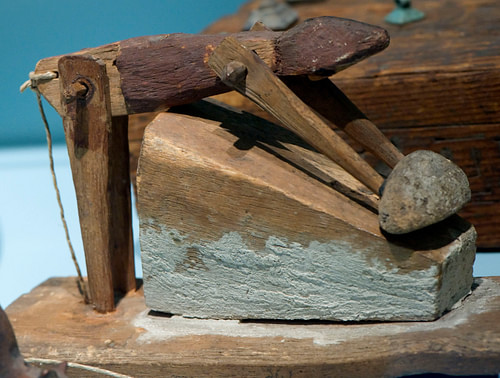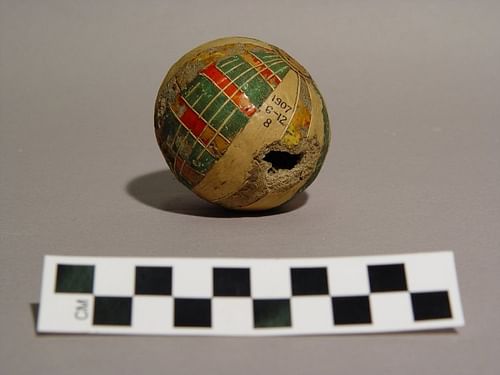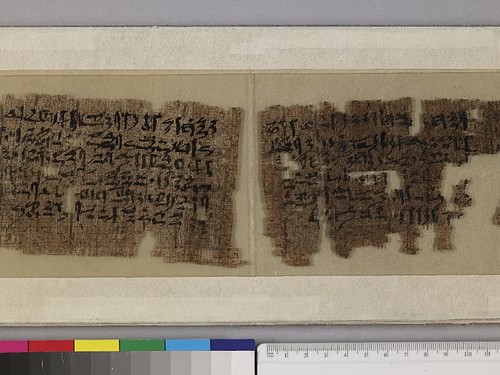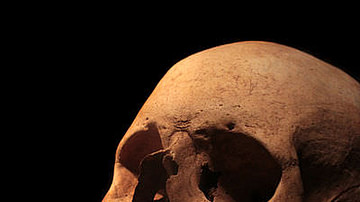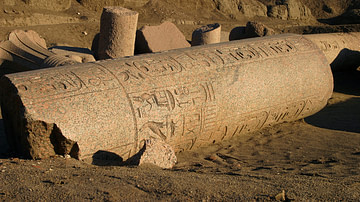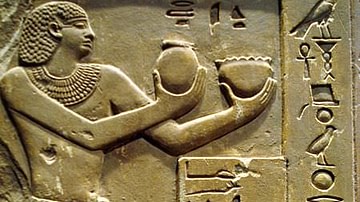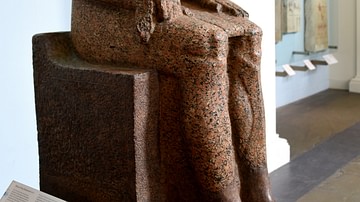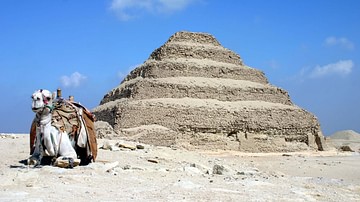Although the ancient Egyptians are often depicted as death-obsessed and dour, they actually had a great appreciation for life and their culture reflected their belief in existence as an eternal journey imbued with magic. Life was a gift from the gods and people were expected to enjoy that gift as fully as possible.
Inscriptions, artwork, and various objects all make clear that ancient Egyptian life focused on enjoying life and making one's time on earth worthy of living eternally. One of the ways they pursued this goal is familiar to anyone in the modern day: through sports and games.
Many of these recreational activities are the same as those in the present day and were played in more or less the same way. Physical fitness was an important part of an ancient Egyptian's life and sports helped one to maintain one's health and vigor. Games were more intellectual pursuits, such as the popular Senet which seems to have been their version of checkers. These sports and games reflected the values of the culture in that they were obviously fun but also contributed to one's overall well-being.
Recreation
Egyptians of every social class spent a great deal of time outdoors from the time they were young. Artwork and inscriptions, as well as letters, provide examples of children playing in the yard or the street from an early age. Boys and girls both went naked from the time they were born until the age of puberty and the figures in many paintings are obviously within this time frame.
Boys also wore their hair in a single side-lock, the rest of the head shaved, in youth, and this aspect is also depicted in many works showing people playing games outdoors. A healthy childhood was thought to lead to a healthy and productive adult member of the community, although, in a seeming contradiction of this value, wealthy priests, scribes, and administrators are frequently depicted as overweight.
Still, athletics and physical fitness played an integral role in the lives of Egyptians of any age. Sports were a part of the king's coronation, celebrations of military victories, religious ceremonies, and festivals, while games were obviously a popular pastime judging from the number of board games found and how frequently they appear in artwork. Senet, in fact, is shown being played by people and the gods in the afterlife and it is thought that the game mirrored one's journey through life toward eternity.
Egyptian children also played with toys, and many of their games are still enjoyed by young people in the present day. Boys and girls did not play together, and their different sports reflected the values expected of the sexes: boys are frequently seen wrestling, rowing, boxing, or playing competitive team sports like field hockey, while girls are depicted juggling, engaged in gymnastics and gymnastic dance. Girls and boys were taught to swim at an early age, and both are depicted at this sport and in boating.
Toys
Many of the toys of young Egyptians were similar to today's action figures and dolls. Egyptologist Rosalie David notes that "young children played with dolls in cradles; animal toys, including crocodiles with moveable jaws; puppets, including dancing dwarfs; rattles and tops; and miniature weapons" (330). They also played with figures of women and men, which were made of clay or wood. An especially intricate piece from the Middle Kingdom (2040-1782 BCE) is a figure (usually interpreted as a woman) kneading dough (also interpreted as grinding grain). This is a pull toy with a piece of string attached to the wooden person who is anchored to a platform and bent over an incline, holding an oval object. When one pulled on the string, the figure went back and forth at its work.
Many toys were attached to pieces of rope or string. There were toy horses and chariots with riders in the New Kingdom (c. 1570-1069 BCE) after actual horses and chariots had been introduced to Egypt by the Hyksos during the Second Intermediate Period of Egypt (c. 1782-1570 BCE). Children also had toy cats, dogs, mice, frogs, and birds. One of these is known as the Saqqara Bird, dated to c. 200 BCE, which certain fringe theorists point to as evidence that the ancient Egyptians understood aerodynamics. Tests on models of the Saqqara Bird have proven that it is not aerodynamically sound, however, and never flew. Aviation expert Martin Gregorie, after exhaustive tests on a model, concluded that it was either a children's toy or a weather vane.
Girls' dolls were made of cloth and stuffed with grass, hay, and, later, horse hair. Boys had figures of athletes and soldiers to play with, which were made of clay, wood, or stuffed cloth. An especially interesting piece, from the New Kingdom of Egypt, is a mechanical dog with a lever beneath (protruding down from the chest) which moves when one presses on its back; the depression and release of the lever moves the dog forward.
Games
Dogs are among the most popular toys, reflecting the value they had for the people, and also feature in a board game known as Hounds and Jackals. The game was popular during the Middle Kingdom of Egypt, and the best preserved was found by Howard Carter (famous for the discovery of Tutankhamun's tomb) at Thebes, dating to the 13th Dynasty. The game was played on an ornate wooden board of fifty-eight holes using playing pieces of pointed wood with dog or jackal heads. The purpose of the game may have been to capture the opposing side's pieces while advancing one's own, but this is conjecture.
One of the oldest board games was Mehen (also known as The Game of the Snake), which dates from the Early Dynastic Period in Egypt (c. 3150 - c. 2613 BCE) and was played on a single-legged board engraved with the image of a snake. Players would use game pieces in the shape of lions and lionesses, as well as round objects, and it is thought the goal was to be the first to box in the serpent on the board. There have been no rules for any of these games found and so any interpretation of their objective is purely speculative.
Rosalie David comments, "there is some difficulty in distinguishing true toys and games (intended to amuse and entertain their owners) from 'dolls' or other figurines used for magical or religious purposes" (330). This is certainly true of Mehen as it could have been a ritual enactment of the Overthrowing of Apophis, a ceremony engaged in to keep the Great Serpent from destroying the barque of the sun god as it traveled through the underworld at night. This possibility is suggested by Mehen boards found in which the serpent engraved on the top is segmented in squares just as Apophis had been hacked to pieces but still posed a nightly threat to the sun. Even so, the squares could simply be spaces on the board for the game pieces with no relation to the Apophis myth.
The most popular board game was Senet, which is most commonly depicted as the 'typical' ancient Egyptian game in television and film (although Hounds and Jackals has made some notable appearances). The game dates from the Early Dynastic Period and remained popular throughout Egypt's history. Senet was a game for two players who faced each other across a board of thirty squares using five or seven game pieces. The objective seems to have been to move all of one's pieces to the opponent's end of the board while preventing them from doing the same. The game is depicted in artwork from the New Kingdom showing royalty playing Senet, the best example being the wife of Ramesses II, Queen Nefertari (c. 1255 BCE) from her tomb painting.
Senet boards have been found in royal tombs from the Early Dynastic Period through the Late Period of Ancient Egypt (525-332 BCE) and in regions beyond Egypt's borders, attesting to its popularity. From the New Kingdom on, it was considered a representation of one's journey from life to eternity as evidenced by texts, inscriptions, and engravings on actual game boards. In The Egyptian Book of the Dead, Senet is mentioned in the early section of the lengthy Spell 17 which firmly links it with the afterlife and the gods.
Sports
The gods were also a part of sports matches and athletics as these were often included in religious ceremonies and festivals. Participants would stage mock battles between the followers of Horus and Set to commemorate the victory of Horus and the triumph of order over chaos. These plays would have incorporated many of the sports Egyptians played on a regular basis.
Some of the most popular sports were fishing, rowing, javelin-throwing, boxing, wrestling, weightlifting, and gymnastics. The most frequently played team sport was field hockey and a game like a tug-of-war played with a hoop. Archery was also popular but mainly associated with the nobility and royalty. Amenhotep II (1425-1400 BCE) was an excellent archer who "was apparently able to shoot an arrow through a solid copper target while mounted in a chariot" (Wilkinson, 234). Ramesses II (1279-1213 BCE) was also known as a skilled archer and hunter who kept himself physically fit throughout his very long life.
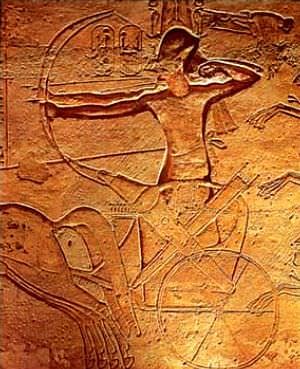
Physical fitness was considered so important for a pharaoh that part of the Heb-Sed festival, held after the first thirty years of a king's reign to rejuvenate him, focused on his ability to run a course and engage in different tasks along the way (including his skill in archery). Princes were encouraged to exercise regularly, especially in the New Kingdom, because they were expected to lead the army into battle. Egyptologist Toby Wilkinson notes:
Energetic and physical pursuits played a particularly important part in the education of future leaders. Running, jumping, swimming, rowing, and wrestling were all part of the weekly routine, designed to develop strength, stamina, and team spirit. (234)
While physical exercise was important for royalty, it was not a value limited by social status. Descriptions of sports indicate that people at every level of society enjoyed them and played often. Egyptian kings are frequently depicted at the hunt, but common people are seen in rowing competitions, water-jousting, competitive races, playing handball, and high-jumping competitions among other sports. These were all played in the same way they are in the present day.
Field hockey was played with two opposing teams using palm branches cut and shaped with curved ends and a ball made of a papyrus center covered with cloth or animal hide. Juggling competitions used the same kind of balls only smaller and sometimes dyed different colors. A mural from Tomb 17 at Beni Hasan depicts two girls facing each other juggling six black balls expertly. The mural is among many found in other tombs, in palaces, and elsewhere which capture the immediacy and vitality of Egyptian sports.
The nobility not only participated in sports but, like everyone else, enjoyed watching them. Among the most popular water sports was shooting-the-rapids in which two people in a small boat would challenge the waters of the Nile. Rowing and swimming competitions, as well as wrestling and javelin-throwing, were equally popular spectator sports.
Men enjoyed watching women's gymnastic dance competitions, pageants, swimming, and rowing in the same way they do today. The most famous literary example of this comes from the Westcar Papyrus (dated to the Second Intermediate Period, c. 1782-1570 BCE) and the story of Sneferu and the Green Jewel (also known as The Marvel Which Happened in the Reign of King Sneferu).
In this tale, the king is feeling despondent and his chief scribe suggests he go boating on the lake, saying, "...equip for yourself a boat with all the beauties who are in your palace chamber. The heart of your majesty shall be refreshed at the sight of their rowing as they row up and down" (Simpson, 16). The king does as suggested, commands that "twenty women, the most beautiful in form, with firm breasts, with hair well braided" be brought and, after spending the afternoon with them, "the heart of His Majesty was pleased at the sight of their rowing" (Simpson, 17). It has been pointed out that the king's pleasure was increased by having all the women take off their clothes and adorn themselves in only netting, but this would have been an acceptable attire for the activity, much as one might change into shorts to go boating in the modern day.
Storytelling
Along with their games and sports, the Egyptians enjoyed another form of recreation equally, and this was storytelling. Although the tale of Sneferu and the Green Jewel highlights how the king's spirits are lifted by watching the beautiful women row him about the lake, the focus of the tale is on the green jewel which falls from one of the women's hair and is lost in the lake. She becomes upset and stops rowing. The king's chief scribe, who has come along on the trip, parts the water on either side and retrieves the jewel. The story relates how "the water was twelve cubits deep" but the scribe uttered his magic spell which folded the water back on itself to create a wall of water which "amounted to twenty-four cubits after it was folded back" (Simpson, 18). The story, of course, is reminiscent of the scene in the biblical Book of Exodus in which Moses parts the Red Sea, and these kinds of tales, of magic and wonder, were among those the Egyptians most enjoyed.
Stories of the gods, tales of heroes like Sinuhe, The Tale of the Shipwrecked Sailor, ghost stories all were told at gatherings, festivals, and parties. These stories often had a moral but this did not lessen their entertainment value or popularity. The Tale of Setna and Taboubu, for example, was a very popular story dating from the first millennium BCE which relates how a prince, lusting after a beautiful woman, surrenders everything, including his family, to have her. He is tricked, however, and finds himself naked in the street after being taught a lesson in respect and prudence by the goddess Bastet.
This story, like the rest, reflected the values of the culture but also aimed to improve a person's soul in the same way that sports kept one physically fit and games provided relaxation and distraction. The recreational activities of the Egyptians all aimed at the same end of enjoyment as well as physical and spiritual improvement in a life which, if lived well, would be lived forever in the paradise of the next world.

